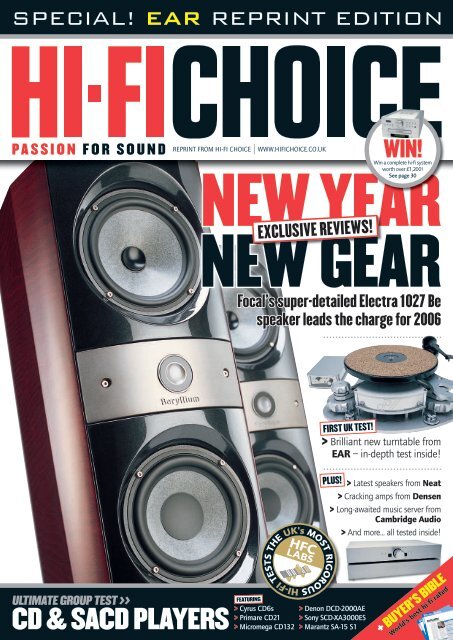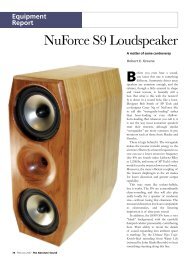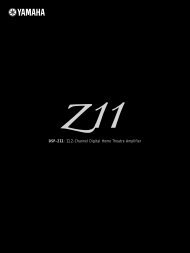Create successful ePaper yourself
Turn your PDF publications into a flip-book with our unique Google optimized e-Paper software.
SPECIAL! EAR REPRINT EDITION<br />
P A S S I O N F O R S O U N D<br />
ULTIMATE GROUP TEST >><br />
<strong>CD</strong> & SA<strong>CD</strong> <strong>PLAYERS</strong><br />
REPRINT FROM HI-FI CHOICE WWW.HIFICHOICE.CO.UK<br />
NEW YEAR<br />
NEW GEAR<br />
FEATURING<br />
EXCLUSIVE REVIEWS!<br />
Focal’s super-detailed Electra 1027 Be<br />
speaker leads the charge for 2006<br />
> Cyrus <strong>CD</strong>6s<br />
> Primare <strong>CD</strong>21<br />
> Micromega <strong>CD</strong>132<br />
FIRST UK TEST!<br />
> Brilliant new turntable from<br />
EAR – in-depth test inside!<br />
PLUS!<br />
> Latest speakers from Neat<br />
> Cracking amps from Densen<br />
> Long-awaited music server from<br />
Cambridge Audio<br />
> And more... all tested inside!<br />
> Denon D<strong>CD</strong>-2000AE<br />
> Sony S<strong>CD</strong>-XA3000ES<br />
> Marantz SA-15 S1<br />
WIN!<br />
Win a complete hi-fi system<br />
worth over £1,200!<br />
See page 30<br />
+ BUYER’S BIBLE<br />
World’s best hi-fi rated
Magnetic charm<br />
Valve amp specialist EAR’s first turntable tears up the rulebook with opposing magnets for isolation<br />
PRODUCT EAR Disc Master<br />
TYPE Turntable<br />
PRICE £7,695 (arm and cartridge extra)<br />
KEY FEATURES Size (WxHxD): 43x16x43cm<br />
P Weight: 24kg P Outboard PSU with 45, 33 & variable<br />
78rpm P Decoupled magnet drive system P Tonearm<br />
outrigger can support two arms<br />
CONTACT 01223 208877 q www.ear-yoshino.com<br />
EAR is one of the UK’s best-established<br />
makers of valve amplifiers, yet it remains<br />
outside traditional valve circles because<br />
EAR amps don’t sound like other valve designs.<br />
Instead, the company’s founder and designer<br />
Tim de Paravicini uses these classic devices in<br />
the same way that others use transistors. With<br />
its first turntable – the company’s first source<br />
component – EAR’s maverick approach delivers<br />
a design that is as radical as anything you’re<br />
likely to see under a piece of vinyl.<br />
The Disc Master turntable’s most ingenious<br />
feature is what’s known as the ‘no contact’<br />
REPRINT FROM<br />
drive system. This is a technique for isolating<br />
the drive system from the bearing, platter and<br />
tonearm, by using opposing magnets. Most<br />
turntables attempt to stop motor energy from<br />
affecting the stylus/groove interface by<br />
decoupling the motor itself and using a rubber<br />
belt to minimise vibration transfer. The<br />
drawback to this approach is that rubber belts<br />
can be inclined to slip very slightly and thus<br />
induce small fluctuations in speed, known as<br />
‘flutter’. By using a system of opposing<br />
magnets in the driven sub-platter and<br />
underneath the bearing, EAR has managed to<br />
engineer a drive system with enough<br />
compliance to iron out motor energy, yet stiff<br />
enough to drive the platter.<br />
The Disc Master turntable has a toothed belt<br />
connecting the motor (which sits upside down<br />
in the case at the front of the turntable) to the<br />
sub-platter. Cleverly, both elements are<br />
decoupled from the spider that supports the<br />
platter and arm by springs inside the three<br />
chunky aluminium feet.<br />
The bearing is also an unusual type that uses<br />
an angular-contact – rather than the popular<br />
point-contact – system, because this approach<br />
is said to give considerably longer life. It feels<br />
stiff to turn when the platter is not on, but this<br />
is because you are also turning the sub-platter<br />
and motor as well as a damped drag system<br />
that’s designed to maintain speed stability.<br />
The gorgeous black platter is made from the<br />
king of kitchen work surfaces, Corian – a<br />
material selected for its very high self-damping<br />
and topped with cork, which is very good at<br />
turning energy into heat. EAR eschews record<br />
clamps because they tend to deform vinyl and<br />
are a bit of a pain to take on and off,<br />
something we can heartily agree with. The Disc<br />
Master has been designed to stop from full<br />
speed within a revolution, so that changing<br />
records is a quick and easy job, one that’s only<br />
marginally inconvenienced by the tight-fitting<br />
centre spindle (and then only with some<br />
records). Its benefit in anchoring the disc to the<br />
platter outweighs the occasional tight squeeze.
You may have noticed that the armboard has<br />
the potential to support a second tonearm –<br />
the aluminium outrigger will let you run an<br />
alternative arm and cartridge combination.<br />
This could be for a 78rpm specific cartridge, or<br />
a set up which suits some albums better than<br />
others (an approach that’s popular in Japan).<br />
The tonearm supplied with our review<br />
sample was a standard Helius Omega (from<br />
£1,485) rather than the forthcoming<br />
EAR-specific Omega, which will include some<br />
functional modifications alongside a silver<br />
finish to match the deck. The Omega is the<br />
latest generation of Helius arms and an<br />
evolution of its Orion and Cyalene forerunners.<br />
Innovations include the main bulk of the<br />
counterweight being fixed to the bearing<br />
body and the placement of the vertical<br />
bearing in front of the lateral one.<br />
SOUND QUALITY<br />
We had a few teething troubles with the first<br />
sample of this deck. Speed stability proved to<br />
be distinctly wanting, but a couple of tweaks<br />
later and it was turning at precisely the right<br />
amount of revolutions per minute. This is<br />
probably because we encouraged EAR to<br />
supply the deck as soon as one became<br />
available, so the company didn’t have the time<br />
to iron out this particular foible. Regular<br />
production samples will not have this problem.<br />
“The turntable’s resolving capabilities are<br />
most apparent when you switch LPs and<br />
hear the difference in recording quality.”<br />
Initially, the Disc Master merely sounds very<br />
neutral and not dissimilar to the SME Model<br />
20 we use as a reference. However, the longer<br />
listening went on, the more it became<br />
apparent that the grooves were giving up an<br />
unusually large amount of information.<br />
Listening commenced with the Helius arm<br />
and a van den Hul Condor cartridge, a<br />
partnership that allows the turntable to turn in<br />
a powerful and fleet-footed performance with<br />
great three-dimensional solidity and a precise<br />
rendition of acoustic space. Its sense of speed<br />
can be pinned down to a total absence of<br />
overhang in the bass. On the one hand, this<br />
means the bass doesn’t have the girth that it’s<br />
capable of; on the other, you get more nimble<br />
and musical bass lines. This quality rather than<br />
quantity approach serves instruments like<br />
double bass extremely well, the turntable<br />
delivering the energy of the music in full effect.<br />
The flip side of this precision is a slight over<br />
exposure at high frequencies that was not<br />
apparent when we swapped over to an SME<br />
Model V arm with the same cartridge. The<br />
EAR Disc Master turntable [ Review ]<br />
Helius Omega does deliver speed and<br />
dynamics with considerable gusto, however,<br />
reminding us of the way that its predecessor,<br />
the Cyalene, used to sound with Voyd<br />
turntables in the 1990s. For many, the ability<br />
to turn on a dime and describe the full<br />
character of an instrument will outweigh the<br />
slightly upward tonal balance tilt with this<br />
arm – it certainly makes for thrilling listening.<br />
With the more relaxed SME V on board, the<br />
calm it brings to the sound does seem to allow<br />
rather more fine detail to emerge, and the<br />
control at low frequencies means that the bass<br />
has all the power and weight you could wish<br />
for. Then again, you could obtain the best of<br />
both worlds by fitting the Helius Omega and<br />
SME Model V, if your pockets are deep enough.<br />
The turntable’s resolving capabilities are<br />
most apparent when you switch LPs and hear<br />
the magnitude of difference in recording<br />
quality that exists. We can’t say we compared<br />
the rumble signature of run-in grooves, but it<br />
was easy to hear how the rumble disappeared<br />
just before the music kicked in on Frank P<br />
REPRINT FROM
[ Review ] EAR Disc Master turntable<br />
Q & A<br />
We talked to Tim de Paravicini,<br />
EAR’s founder and designer,<br />
about the intricacies of the<br />
Disc Master’s unusual design<br />
HFC: Why build a turntable now?<br />
TdP: Because I’ve spent 20 years thinking about<br />
the problems [of turntables] and secondly, 20 years<br />
ago I would have had to market it against the Linn<br />
LP12... forget it! The Linn was so effectively<br />
marketed back then, it would have been like trying<br />
to start up against McDonalds.<br />
Can you tell us more about the bearing?<br />
The angular-contact bearings are hideously<br />
expensive and made in Switzerland; they are<br />
normally used in ultra high-speed spindles. With<br />
the loading I have on them they should certainly<br />
last ten years, if not a lifetime. They have lower<br />
rumble and lower noise than any other bearing<br />
structure. They are also stiffer in side-to-side motion<br />
than any single-point bearing.<br />
Are there no problems with placing the motor<br />
under the arc of the stylus?<br />
It’s such a long distance away, the effect is<br />
immeasurable. If it’s not measurable on the output<br />
of the cartridge when it’s resting on the vinyl, then<br />
it’s a nonentity. It’s the same with the magnetic<br />
coupling: there is no stray field that affects or<br />
produces any subsonic signatures. All the subsonic<br />
signatures you hear are inbuilt deformations in the<br />
records when they are pressed, and you should be<br />
able to hear a different rumble signature on every<br />
record you play. This is because the lead-in grooves<br />
all sound different – on a normal turntable, there’s<br />
enough basic rumble in the system that you can<br />
never quite hear all that. The Disc Master is<br />
different. I wanted to hear only what existed on the<br />
record and not other effects. Even turntables with<br />
50kg platters have significant inbuilt rumble,<br />
because of the heavy loading on the bearing.<br />
What’s the Helius connection?<br />
I’ve known Geoffrey for many years and I’ve always<br />
thought that his arms are better engineered – in a<br />
technical sense – compared to other arms. They are<br />
fundamentally well thought out and his bearing<br />
structure is unique and clever. The Omega is also a<br />
genuine 10in (25cm) arm which gives you less<br />
angular (tracking) error – you can keep 90 per cent<br />
of the record under one degree of error.<br />
REPRINT FROM<br />
Detail<br />
Magnetically decoupled drive<br />
sits below bearing<br />
Platter:<br />
Corian with cork<br />
upper surface<br />
Armboard:<br />
Aluminium, accepts<br />
two tonearms<br />
Q Zappa’s One Size Fits All and just as easy<br />
to hear the coherence and separation of<br />
instruments and voices within the dense mix.<br />
What the deck does best is to reveal how much<br />
better some recordings are than others, how<br />
much quieter the background is and just how<br />
strong a sense of three-dimensionality some<br />
engineers manage to achieve with the<br />
medium. John Fahey’s Visits Washington DC<br />
album revealed not only the extraordinary<br />
timbre that he gets out of a steel string guitar,<br />
but also the scuffling of his fingers on the<br />
body of the guitar as he picks the strings.<br />
Timing is another strong point of the EAR<br />
Disc Master. One’s foot or fingers rarely sit still<br />
and the rhythmic qualities of the material<br />
shine through. The Helius arm emphasised this<br />
with its balance, but it’s there in equal measure<br />
with the SME too, albeit rather more<br />
Bearing uses angular races<br />
for longevity and low noise<br />
subliminally presented. Combine a great<br />
recording with a musician that has a fine sense<br />
of timing – something like Keith Jarrett’s Eyes<br />
of the Heart – and you have a musical feast of<br />
extraordinary depth and richness. Even the sax<br />
playing here comes across better than Coltrane<br />
on Kind of Blue, because the recording is so<br />
much more real.<br />
The Disc Master’s level of resolve will make it<br />
more apparent which of your albums are the<br />
better recordings, but it will also extract every<br />
last scrap of detail from the lesser ones. It is an<br />
extraordinary turntable in many ways, from the<br />
innovation of its design to the gripping clarity<br />
of its sound. Make no mistake: this is a highresolution<br />
deck, yet the music always come<br />
first – whatever tonearm (or tonearms) you<br />
choose. HFC<br />
Jason Kennedy<br />
VERDICT<br />
SOUND >> 96%<br />
FEATURES >> 88%<br />
BUILD >> 88%<br />
VALUE >> 83%<br />
Armboard clamps to bearing<br />
housing has two arm mountings<br />
Suspension spider:<br />
Aluninium with multispring<br />
isolation in feet<br />
Motor housing/base:<br />
Aluminium with<br />
adjustable feet<br />
R PRO<br />
Combines new technological<br />
solutions with high-quality<br />
materials to bring state of the<br />
art resolution to good ol’<br />
analogue audio. Second arm<br />
option surprisingly handy.<br />
S CON<br />
Early samples had speed<br />
stability issues and motor<br />
noise is a little higher than<br />
average. It’s also a bit of a<br />
‘mare to dust!<br />
CONCLUSION<br />
It’s hard to break new ground in a technology that’s a century<br />
old, but EAR has done just that. This turntable is extremely<br />
neutral, and has the ability to tell you exactly how your records<br />
(or even your tonearms) sound.<br />
OVERALL SCORE 90%<br />
>>







